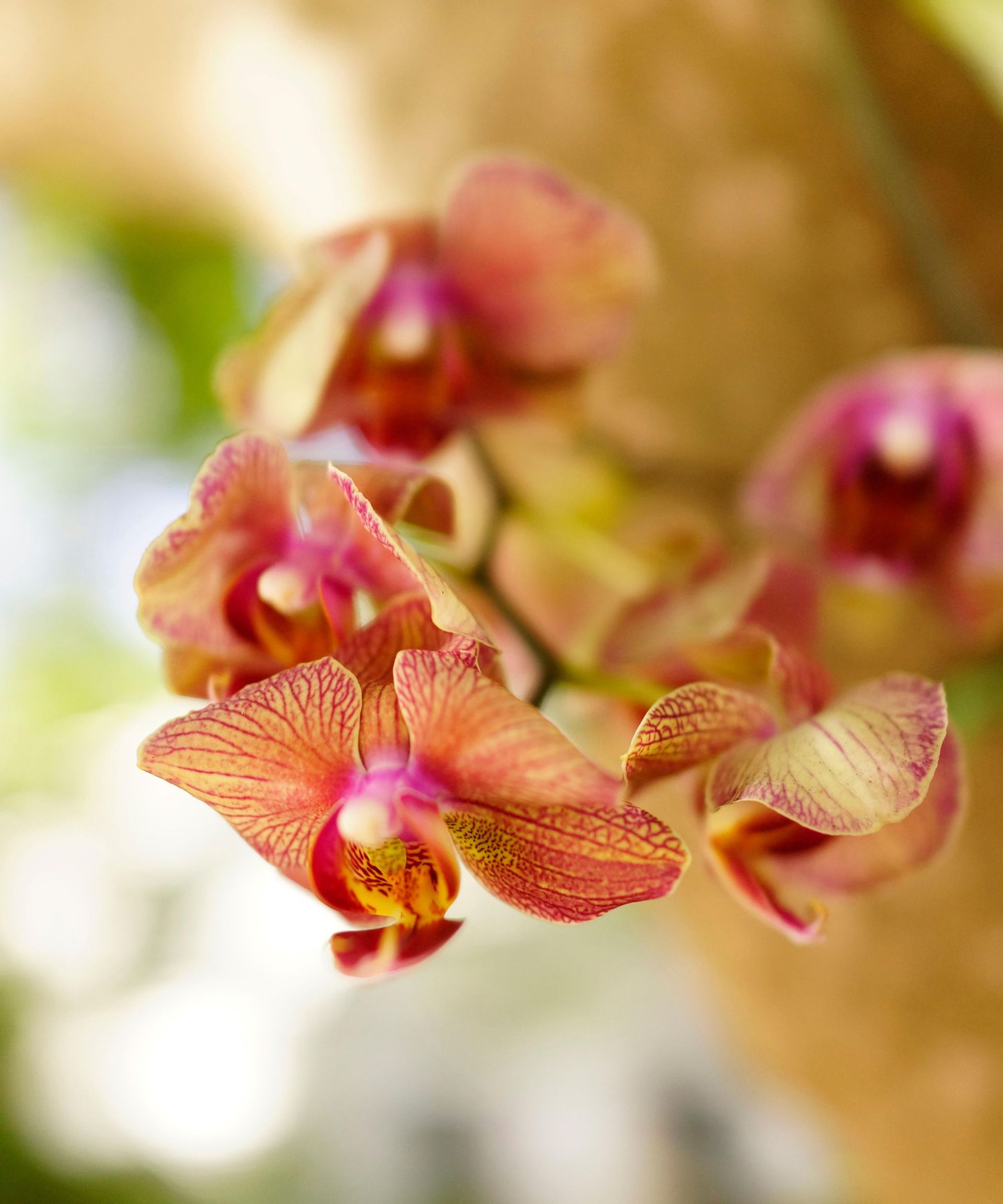How to prune orchids – or are yours best left untouched? Experts advise
Pruning orchids is a divisive subject. Here, we clarify when to, and when not to cut your plants – and how
- (opens in new tab)
- (opens in new tab)
- (opens in new tab)
- Sign up to our newsletter Newsletter


Pruning orchids is simple, BUT... not all orchids are pruned in the same way, and some experts say some are better left unpruned. So before you consider cutting yours, it is really worth checking which orchid type you are dealing with, and how it likes to be treated, particularly when it comes to pruning.
This is a vital part of orchid care; these beautiful but delicate indoor plants are very choosy about where they are positioned, room temperature and humidity – plus you'll need to know exactly how to water orchids so as not to kill them off before their time.
So, how do you prune orchids, and which orchids do and don't need trimming? Experts offer their advice below.
How to prune orchids
Phalaenopsis orchids (also known as moth orchids) bloom for up to three months; Dendrobium orchids flower for up to six weeks. Both require pruning, but with different approaches.
How to prune phalaenopsis orchids

Once a Phalaenopsis orchid's flowers have dropped, you can prune off dead stems and roots. Many experts agree that this will improve the plant's health and boost future blooms and leaf growth. However, the consensus isn't absolute, and you should try to nurse an orchid with yellowing leaves back to health before pruning the plant.
‘Orchids don't need to be pruned!’ says says Valeria Valkova, head of the nursery at world-famous grower McBean's Orchids (opens in new tab). ‘If you leave orchid stems on your moth orchid it will reflower again and again. However some types will only flower once: including cymbidium, oncidium and vandac. As a general rule, if the flower is green, leave it. If it goes brown and dry, cut it.’
While pruning isn’t a necessary part of orchid care, you do need to occasionally trim the stem, even on moth orchids. This is sometimes case if the orchid stem is turning yellow.
To do this, ensure you prune your orchid with sharp scissors. Doing so minimizes the chances of damage and disease. Use the scissors to remove fading or dead flowers, and only cut the stem when all the orchid flowers have died.
‘After the last flower expires, cut the spike above the node (the bumps on the stem) from which the first flower appeared,’ says Paige Harmon at Westerlay Orchids (opens in new tab).
These bumps on the stem tend to be brown in color; cut around half an inch above them.
‘A new spike can branch off within weeks. Alternatively, remove the flower spike entirely to allow the plant to recover and form a new spike in 3-4 months.'
Once all the flowers are spent, the plant is likely dormant (this usually happens in fall), and can be pruned more dramatically. Remove any dead or dying stalks right back to the roots, and take healthy stalks that have finished blooming down to around an inch from the main stalk. Healthy stems should then regrow.
If you are wondering when to repot an orchid, this is a good time, and you can take the opportunity to prune out any dead or broken roots. You can tell orchid roots are ready to be pruned out if they are soft and brown; they should be white and firm.
How to prune dendrobium orchids

Dendrobium orchids require a slightly different approach. These shorter-flowering orchids can surprise and delight you by producing blooms again a year after they have dropped their flowers.
To keep them healthy, and to encourage these new flowers, nip off the flowers as they die off, but don't cut the stem back. Once all the flowers have died off, leave them in a spot they like (you may want to move them to a less conspicuous spot since a bare stem isn't that alluring), and wait for flowers to reappear on the stalk in a few months' time. You can, of course, check the orchid's roots for pruning and repot it if you think it needs it.
When should orchids be pruned?
Orchids should be pruned only once the flowers have died off, usually when temperatures drop in fall. Fading flowers can be nipped off to keep your orchid looking neat, but don't cut the stems on Phalaenopsis orchids until all the flowers have dropped; and don't cut the stems on Dendrobium orchids at all; instead, leave the plant with bare stems in a place it's happy and wait for it to reflower.
Should I trim my orchid after the flowers fall off?
You can prune Phalaenopsis orchids' stems once all the flowers have fallen off. This will ensure healthy growth, more blooms and bigger leaves in future. However, Dendrobium orchids don't like their stems to be cut, even after the flowers fall off. Instead, allow the bare stems to produce blooms again next year. That said, dead stems and roots can be removed to promote healthy growth.
Where do you cut an orchid after the flowers fall off?
After the flowers fall off, cut green Phalaenopsis orchid stems around half an inch above the node (the bumps on the stem) from which the first flower appeared. If stems have died off – the clue is that they have gone brown – take them right back to the roots. Do not cut Dendrobium orchids' stems.
How far back should I cut my orchid?
Phalaenopsis orchid stems can be cut around half an inch above the node from which the first flower appeared. Dead, brown stems can be taken right back to the roots. If your orchid has two stems, take one back to the roots, and trim the other at half an inch above the node (the bumps on the stem) from which the first flower appeared. Do not cut Dendrobium orchids' stems.
How do you cut back an orchid to rebloom?
Cutting back a Phalaenopsis orchid stem to around half an inch above the node from which the first flower appeared – once the flowers have dropped – will encourage it to bloom, though be aware that not all orchids will produce new flowers. Equally, removing dead, brown stems to the roots will allow the rest of the plant to concentrate its energies on the healthier parts of the plant. Two stemmed orchids should be cut differently: take one stem back to the roots, and trim the other at half an inch above the node from which the first flower appeared. Do not cut Dendrobium orchids' stems, as it will rebloom on the existing stem. In the case of both orchid types, trimming out dead or dying roots and repotting will encourage healthy growth, as will ensuring it is in a spot it likes.

Lucy Searle has written about interiors, property and gardens since 1990, working her way around the interiors departments of women's magazines before switching to interiors-only titles in the mid-nineties. She was Associate Editor on Ideal Home, and Launch Editor of 4Homes magazine, before moving into digital in 2007, launching Channel 4's flagship website, Channel4.com/4homes. In 2018, Lucy took on the role of Global Editor in Chief for Realhomes.com, taking the site from a small magazine add-on to a global success. She was asked to repeat that success at Homes & Gardens, where she has also taken on the editorship of the magazine.
-
-
 Robert Pattinson just bought a Spanish Colonial-style home – with an interior designer past
Robert Pattinson just bought a Spanish Colonial-style home – with an interior designer past'The Batman's' Robert Pattinson and Suki Waterhouse purchased the Jeff Lewis-designed Hollywood Hills estate for $5.3 million
By Megan Slack • Published
-
 7 expert-approved methods to remove candle wax from carpet
7 expert-approved methods to remove candle wax from carpetCleaning professionals share their tips on how to remove candle wax from carpet
By Millie Hurst • Published

